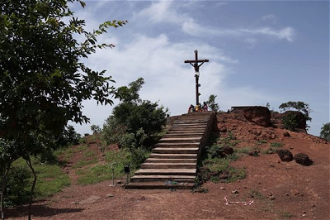Fr Robin Gibbons: Reflection on the Feast of Meeting, The Presentation of the Lord

Icon Presentation of the Lord in the Temple, Andrei Rublev 1405
In the wonderful eastern icons of the feast of the Lord's Presentation, six living beings form the composition of the Icon. Simeon his hands covered in an attitude of reverence bows towards the child held in his arms, who is blessing Simeon and we who gaze on the image.
The Temple doors are shut because the true presence of God is now revealed in Christ. Facing Simeon is Mary who has handed over her child, a time of poignancy and uncertainty especially in what will now happen! Then there is Anna actively praising God, usually holding a scroll which denotes her status as a prophetess and lastly Joseph holding in his covered arms the two little turtle doves who are the redemption sacrifice for Jesus. In a curiously sympathetic way the doves mirror Jesus' own position in Simeon's arms. Those two symbols of peace and innocence soon to be sacrificed haunt me awhile.
In my minds eye I see those birds of peace juxtaposed with the Christ child, hinting at those very disturbing words of Simeon to Mary, "This child is destined to cause the falling and rising of many in Israel, and to be a sign that will be spoken against, so that the thoughts of many hearts will be revealed. And a sword will pierce your own soul too." Jesus like the innocent birds offered in sacrifice is a real sign of contradiction; I find the innocence of their sacrifice problematic, why do they have to die? But then too Jesus who is the Lamb of redemption for us all in his death on the cross is a stumbling block a conundrum throughout history!
What can we make of the feast and Luke's account of it? It is the oldest of the ancient feasts of Mary the Theotokos who is being purified after childbirth, but it is also a feast full of meetings, which is how the Eastern Church calls it, Hypapante, the encounter with the Lord Christ. It connects with those other nativity festivals of Theophany/ Epiphany, Baptism and Cana, for in all of them the Spirit reveals the beloved Son.
Here it is Simeon at the very end of his life witnesses to the light that has come into the world, the word made flesh, but it is also tacitly understood that Joseph too, doubts ended, is reconciled to Mary his wife and trusts in the promises of God, and Anna, the praying person who has devoted most of her life to the service of God but now becomes the preacher and teacher of this revelation.
There is much for us to contemplate, the fragility of our human nature, in Jesus God has been literally handed over in trust first to Mary, now to Simeon, these are the ones who accept him and see the revelation of love, but there will be others who will reject him, actively hurt him and seek to kill him. That perhaps is the tension I pick up, not only in Simeon's bitter sweet words to Mary, but also in that small poor sacrifice of doves, symbols of innocence and peace. How many other innocents have been and will be sacrificed for others needs? How many times do we fail to perceive the Christ who comes to meet us in situations and moments?
But there is also a deep sense of hope, that birth and death belong to the Kingdom of God, will in the end come right! What Simeon has seen with his eyes, the salvation of God's people, is fulfilled throughout all of history, we too see salvation, it is here now and wherever we gather in the Lord's name, wherever charity and love are. We too are called to meet the Lord daily, weekly, until that moment when we too are called to go forth in peace. In the end it is the sacrificed doves and lamb, the little ones, the meek ones that inherit the earth. As Jesus said: 'Blessed are those who are persecuted for righteousness sake: for theirs is the kingdom of heaven'. The sign of contradiction becomes the sign of reconciling love.
Thomas Merton's Poem Candlemas 1943
Lumen Ad revelationem gentium.
Look kindly, Jesus, where we come, New Simeons, to kindle, Each at Your infant sacrifice his own life's candle.
And when Your flame turns into many tongues, See how the One is multiplied, among us, hundreds! And goes among the humble, and consoles our sinful kindred.
It is for this we come, And, kneeling, each receive one flame: Ad revelationem gentium.
Our lives, like candles, spell this simple symbol: Weep like our bodily life, sweet work of bees, Sweeten the world, with your slow sacrifice. And this shall be our praise:That by our glad expense, our Father's will Burned and consumed us for a parable.
Nor burn we now with brown and smoky flames, but bright Until our sacrifice is done, (By which not we, but You are known) And then, returning to our Father, one by one, Give back our lives like wise and waxen lights.


















